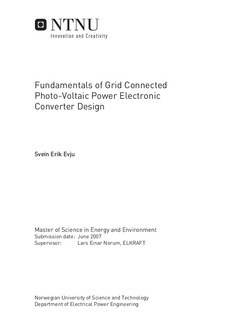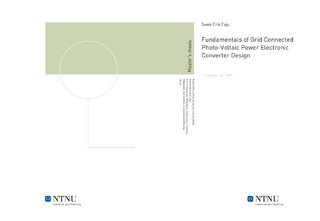| dc.description.abstract | In this master thesis the basic theory of grid connected photo-voltaic systems is explained, giving an introduction to the different aspects of system design. Starting with a look at the standards concerning grid connection of distributed resources, and working its way through how the photo-voltaic cells work, to how photo-voltaic modules with electrical converters can be arranged. Some different converter topologies suitable for use with photo-voltaics are found, and based on these topologies, solutions for how to control these converters have been examined. These controls involve methods for utilizing the maximum power from solar panels, methods for synchronizing with the grid and methods for current and voltage control. Based on this theory a system model is made, including an isolated current fed full bridge DC-DC converter in cascade with a three phase full bridge DC-AC converter having a LCL filter as grid interface. This model is simulated in Simulink and experiments are made on a laboratory setup, where focus has been on the control system. Therefore linear system models of the control system has been made, and these have formed a basis for the optimization of the control systems. The simulations have been made using Simulink, and the control system for the converters has been implemented in two DSP’s, one for each converter. The design and construction of the DC-DC converter has been made in this thesis, but it showed out to be more complicated then first assumed. Because of this, too little time was spent in the design of the circuit and too much time was spent on testing and correcting errors. It ended with a non-functional converter, and therefore the experiments made had to be done without the DC-DC converter. However the report shows that the isolated current fed full bridge DC-DC converter is a promising topology in photo-voltaic systems, and should be investigated closer. It is found in the simulations and experiments made, that the system models derived give a dynamic response close to the real, and are suitable for giving a basic understanding of the system dynamics and for optimizing the control system. The control system consists of a maximum power point tracker which effectively finds the point where the photo-voltaic modules delivers the highest power, and in order to synchronize to the grid voltage a phase locked loop is used, which locks the converter output to the grid voltage in less then 10ms. In order to control the power flow into the grid, current control in a rotating reference frame locked to the grid voltage is used. This has simplified the control since it gives DC-values stationary, and has made it possible to separately control the active and reactive power flow. Most of the tests made in the simulations and experiments have been made with operating conditions close to ideal. In order to verify how the system handles varying operating conditions, and to see if it coincides with the requirements in the standards, more extensive testing should be made of the system. This includes testing with varying irradiance of the solar panels, grid disturbances and grid failures. | nb_NO |

